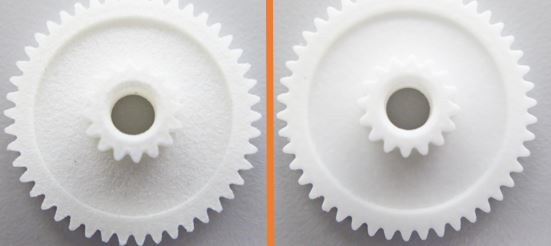Reduction of the surface roughness of plastic components with chemical smoothing
igu-blog-adm | 25. March 2019
Which 3d printed plastic components are suitable for this? Which ones are not?
In contrast to vibratory grinding, the geometry of the component does not have a significant role in chemical smoothing – the suitability of the parts is virtually independent of geometry.
Topic wall thicknesses: here it is important to avoid thin wall thicknesses as much as possible. Components with a wall thickness of less than 0.8 mm are considered unfavorable – otherwise the risk of structural changes increases considerably. The same applies to narrow bores – diameters smaller than 0.4 mm are also considered unsuitable. Attention! Dimensional deviations of 0.1 to 0.4 percent are possible.

At what temperatures are the components treated? Are there deposits of chemical residues on the components?
The smoothing process takes place at moderate temperatures between 30° C and 40° C. During the subsequent drying process, maximum temperatures of up to 70° C are reached.
Don´t worry – chemically smoothed components usually have no residues.
How much does the chemical smoothing of my plastic part cost? And how long does it take to deliver the parts?
In general, the minimum order quantity is 22.50 euros.
Depending on the complexity of the component, production by selective laser sintering takes between 24 hours and three days. If the components are subsequently to be chemically smoothed, the delivery time is extended by approx. 9 to 11 working days.
Summary:
Here’s your problem:
- You need a service that allows you to have printed plastic wear parts produced in a short time.
- You also have to meet certain precision requirements and reduce surface roughness.
Your options:
- You will use the 3D printing service to request your part or to order it directly.
- Alternatively, you can also contact an expert directly to get detailed advice on a suitable surface treatment process.
You will receive the following benefits:
- You will receive a non-binding offer within 24 hours.
- You get your printed parts, depending on complexity, number of pieces and reworking service, between 1 and a maximum of 15 working days.
